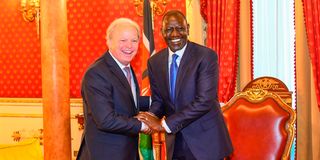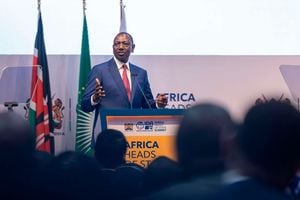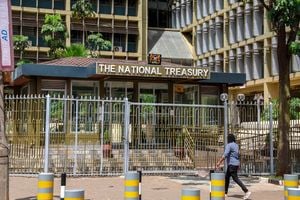
President William Ruto with World Bank Group Senior Managing Director for Development Policy and Partnerships Alex van Trotsenburg in January 29, 2024.
The World Bank (WB) and the International Monetary Fund (IMF) have, for the first time, confronted damning accusations of reckless lending to Kenya, even as their rebuttals are disputed by audits and budget reports.
At a time when Kenya is battling a Sh10.5 trillion debt and reports of hundreds of billions in borrowed money that can’t be traced to any project, in candid responses to the Nation, the Bretton Woods institutions addressed concerns about the cost and legitimacy of the loans.
Busia Senator Okiya Omtatah and Safina party leader Jimmy Wanjigi have publicly stated Kenya has overpaid its debt obligation by over Sh1 trillion “according to the revenue books of the government” and Mr Wanjigi has claimed Kenya should not repay “odious” debt that he claims was never spent on development in accordance with the laws.
The Auditor-General and the Controller of Budget (CoB) have also questioned the true cost of “concessional” loans with rising calls for a transparent forensic audit of the country’s debt.
By end of April, Kenya owed the two multilateral lenders a combined Sh1.9 trillion.
Kenya owes the World Bank Sh1.5 trillion and currently there are 36 ongoing projects funded by the lender, valued at more than Sh950 billion.
“The WB and the GoK (Government of Kenya) engage in a dual due diligence process that spans the entire project lifecycle, from inception to completion,” the lender says, adding that the State’s due diligence “determines the viability of the proposed project before Cabinet approval”.
“After Cabinet approval, the sector ministry prepares the project in close collaboration with the Bank team while the Bank management provides guidance at critical preparation milestones to ensure the project is robust and effectively meets the country’s expressed needs,” the lender adds.
It says prior to approving loans, it undertakes “a comprehensive appraisal” to assess a project’s feasibility and readiness of an entity to implement it.
“Over the past decade, Kenya’s electrification program, supported by World Bank initiatives like the Kenya Electricity Expansion Project and the Kenya Electricity Modernization Project, has dramatically increased access to electricity from 25 per cent to 75 per cent. This has resulted in over 4.6 million household connections, impacting nearly 18 million people,” the lender says.
While the lender takes credit for the project, an audit last year faulted the implementation, exposing delays, and supply of faulty equipment that caused blackouts.
Together with the African Development Bank, the WB was to fund Sh47 billion of the Sh63 billion cost of the project.
While the audit credited the project for creation of jobs, an increase in small businesses, enhanced security and extended study hours for school children, it noted that all phases of the project delayed and none had been completed by April 2022.
Five out of the six WB-run contracts in the project, which ought to have been completed by 2019, were still ongoing, the audit established. It noted that the delays caused a rise in costs of the project, with one case attributed to the debarment of a firm that was implementing part of the project.
“Lot 1 of Phase II was being implemented by British Engineering Services Limited (BES) in a joint venture with Ultimate Engineering Limited. A total of 25,255 beneficiaries were to be connected under the contract. In July 2019, the World Bank debarred Ultimate Engineering Ltd for a period of three years for misrepresenting its financial qualifications, in connection with their bid. Consequently, project works were on hold until June 2020, when Kenya Power and Lighting Company signed a new contract with BES,” the audit noted.
Auditor-General Nancy Gathungu noted that households connected to the national grid through the initiative experienced unreliable power supply due to faulty meters and blackouts due to transformer breakdowns.

President William Ruto and Lydia wanjiku Nganga during the launch of the Cianthia Village Last Mile Electrification Project in Mbeere North.
“Review of correspondences between KPLC and the supplier of pre-paid meters revealed that 21,539 of the 312,500 meters became faulty either during installation or after brief usage by the beneficiaries,” the audit stated.
It also established that three-quarters of the 606 sampled beneficiaries experienced power interruptions averaging five times in a month, half of whom experienced dimming of lights and inability to power appliances.
The audit also exposed cases where Kenya Power installed meters and service cables to non-existent households.
“Despite the Project’s successes, it did not achieve fully the objective of connecting the targeted 766,173 beneficiaries within the stipulated timelines. As at the time of the audit in April 2022, a total of 683,762 beneficiaries had been connected to electricity, representing 89 per cent of the targeted beneficiaries,” Ms Gathungu concluded.
The lender also credits itself for the Kenya Youth Employment and Opportunities Project (KYEOP), an initiative started in 2016 to offer funding to youth to start businesses.
“The KYEOP has significantly impacted youth employment, with key achievements including the launch of 86,000 businesses, creation of 125,000 jobs, and a 50 per cent income increase for participants,” the WB says.
Under KYEOP, over 87,000 youth got Sh40,000 each as seed capital to fund their startups while others won up to Sh3.6 million to support their business ideas. By last year, Sh15 billion had been pumped into the project, out of which Sh9.2 billion constituted loans from the WB.
When auditors went to the ground to establish the impact of the Sh15 billion spending, however, they could not reach about half of the beneficiaries they sampled.
“They were either unreachable on phone or non-cooperative by not willing to give directions to their premises, while some indicated that their businesses had failed,” the audit report stated.
A number of other WB-funded projects have been revealed to be facing delays or have stalled.
An audit on the Horn of Africa Gateway Development Project—a key road connecting Kenya, Somalia and Ethiopia—revealed that it faced funding shortfalls in the year to June 2023 due to “Covid-19 pandemic and delayed processing of No Objections approvals by the World Bank”.
Another audit last year revealed that the WB had to cancel a loan to fund construction of Mwache dam on realisation that the project’s funding needs had exceeded projections, delaying the project for five more years to 2026.
“This cancellation, together with foreign exchange losses, resulted to a significant financing gap approximated to $137 million (Sh20,337,650,000),” the audit noted.
The WB reckons that “sometimes, specific expenditures in a project may be subject to readiness conditions that the borrower or implementing entity is required to fulfil before disbursement can be made”.
“If the GoK fails to comply with its obligations under the relevant legal agreement, the WB can exercise its remedies. These include but are not limited to the rights to suspend or cancel amounts provided under the financing,” the World Bank says.
An audit also shows that it is impossible to assess the performance of an urban transport project the WB was financing at 80 per cent of the costs, after the agreement was cancelled in December 2018. This is despite the bank saying that before approving financing, it does due diligence and looks at a project’s life cycle.
Kenya owes the IMF Sh433.6 billion and has been in a borrowing programme with the lender since April 2021 that will see it borrow $3.9 billion (about Sh500 billion by current exchange rates) by April next year.
While the borrowing framework with the IMF is not tied to projects as is the case with the World Bank and other development banks, the IMF’s Extended Fund Facility (EFF) and Extended Credit Facility (ECF) have had huge implications due to the conditions attached.
“The IMF provides financial support to countries hit by crises to create breathing room as they implement policies that restore economic stability and inclusive and sustainable growth,” the lender says.
When the programme started in April 2021, IMF conditions included increase of taxes to grow the country’s taxes as a share of Gross Domestic Product (GDP) and structural changes in government to cut unnecessary spending.
“A key pillar of the strategy is to bring the tax-to-GDP ratio back to levels achieved in recent years (from 12.9 per cent of GDP in FY20/21 to 15.6 per cent in FY23/24), so as to generate resources to meet Kenya’s development needs,” the first Kenya-IMF borrowing programme report noted in April 2021.
As a result, the government ended tax relief measures introduced during the Covid-19 pandemic and has introduced new taxes and levies, and increased others. Increased taxes include VAT on fuel and extra Pay-As-You-Earn tax on high earners.
The programme has, however, had little impact in growing Kenya’s taxes and cutting wastage in government.
Kenya’s tax-to-GDP ratio in the 2023/24 fiscal year stood at 14.9 per cent and wastage continues to be witnessed, with cost of running government operations crossing Sh1 trillion for the first time in the 2023/24 fiscal year.
“Promoting good governance remains an essential part of the IMF’s engagement with the Kenyan authorities,” the IMF maintains.
The IMF told the Nation that through the programme, the government has had to publish a new ownership policy for commercial State corporations (SOEs)and passed a law for publication of beneficial owners of companies winning public tenders.
“The authorities’ program contains specific commitments to protect public resources, enhance transparency and accountability to reduce corruption risks, and better manage SOEs,” it says.
IMF adds that during loans disbursements, it has been conducting periodic reviews on how the government is implementing agreed policies and programmes.
Audits and CoB reports, however, continue to reveal wastage in government running into billions of shillings every year, which make it difficult to assess the impact of the IMF loans.
CoB Margaret Nyakang’o has previously called for an audit of concessional loans to trace projects they have been funded, while sounding an alarm that their interest goes as high as 14 per cent, an accusation the lenders deny.
“Our analysis has revealed that the average interest paid on concessional loans has averaged 14.5 per cent for many years, which is not cheap by any standards. Most of the so-called concessional loans might possibly be very expensive in the long run and with a low impact in terms of economic development,” Dr Nyakang’o told the Public Debt and Privatisation committee in February.
“The Controller of Budget recommends a special audit of existing and committed loans to link the loans with the projects funded through borrowed funds,” the office stated in its report for the year to June 2023.
The World Bank told the Nation that the combined interest rate and service charge on International Development Association (IDA) loans—the agency it uses to issue project loans— is 1.4 per cent.
“This is the best rate available because Kenya has opted to take the credits in Euros rather than SDRs, which is the standard currency and for which the combined rate would be 2 per cent,” the lender said.
The IMF says that under its ECF programme with Kenya there was “no commitment fee given the concessional nature”.
Documents seen by the Nation show that part of the billions of shillings Kenya has paid as commitment fees, charges and penalties, more than Sh600 million, went to multilateral lenders.
The WB, Kenya’s largest multilateral lender, says Kenya is exempt from paying commitment fees on IDA loans because of annual waivers granted by its board of directors.
“Therefore, there have been no penalties for Kenya regarding unwithdrawn funds from these concessional financing arrangements,” it says.
The lender also notes that its loans, related to Development Policy Operations (DPOs), don’t attract commitment charges.
“On these loans, the National Treasury (NT) has paid a Front-End-Fee (FEF) of 0.25 per cent prior to disbursement. The FEF’s have been capitalised and not paid from the NT-Budget. The cost of the IBRD loans is indexed to Secured Overnight Financing Rate (SOFR) with a fixed interest that is negotiated as per the selected loan choice at the time of negotiations,” it says.
Despite the World Bank’s and IMF’s structures and conditions that have instilled some discipline in government borrowing and spending, the audits reveal that even in their projects, there exist loopholes that they have been unable to control, causing wastage of billions of shillings.
When it gets to commercial borrowing by the government, things get even murkier.
A special audit in July revealed that Treasury could not show projects funded with at least Sh1.13 trillion of expensive loans borrowed externally between 2010 and 2021.
“The special audit established that although the proceeds from the 13 syndicated loans and sovereign bonds totalling Sh1,129,703,842,485 had been received in the Consolidated Fund, there was no evidence that the funding had been applied exclusively to finance development expenditure,” Ms Gathungu said.
It is a requirement under Kenya’s Public Finance Management (PFM) Act, 2012, that money borrowed by the State must be used to fund development projects.
“It was noted that once the loan proceeds have been received in the Consolidated Fund, the monies are utilised for normal government expenditures that are falling due at the time of receipt of the said funds,” Ms Gathungu noted in the special audit on usage of commercial loans.
During the audit period, Treasury took 39 commercial loans valued at Sh1.36 trillion, of which the Sh1.13 trillion could not be traced to projects.
The plunder of loans is rampant even as the country is littered with white elephants, the product of the government’s ineptitude when seeking loans, where it has borrowed hundreds of billions of shillings to fund poorly planned projects and others that were just a front to steal public funds, and have eventually stalled.
As of March this year, a report by Treasury estimated that at least 442 projects valued at Sh663 billion had stalled across the country. The projects require about Sh787 billion to complete.











